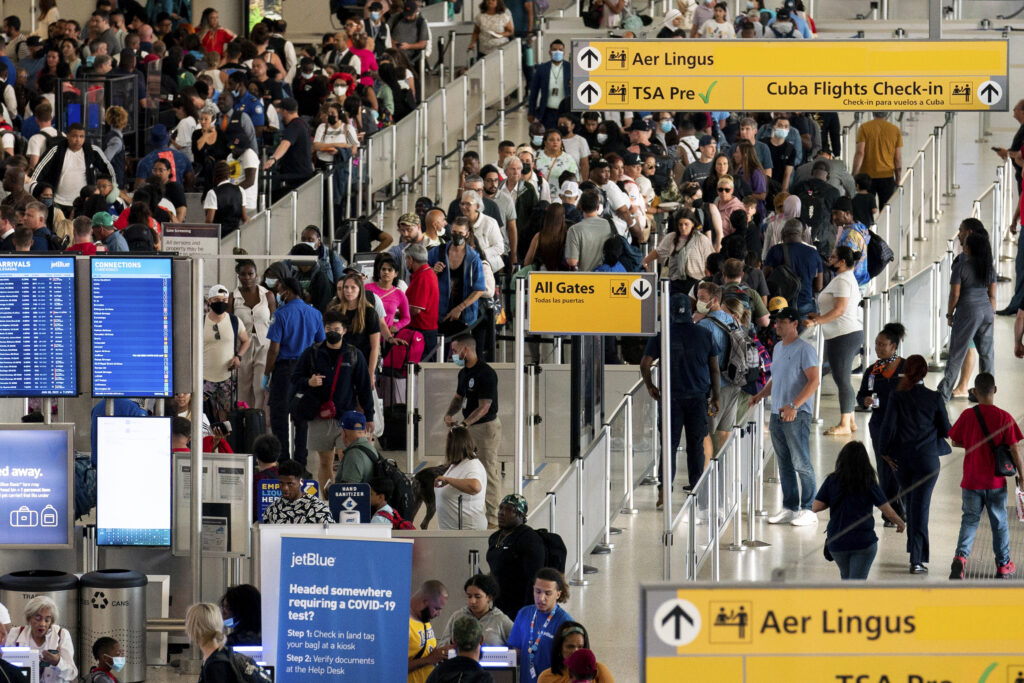Airlines: Business Travelers can retain Recovery Pace
Newslooks- DALLAS (AP)
With summer vacations winding down, airlines are counting on the return of more business travelers to keep their pandemic recovery going into the fall.
Air travel in the United States, bolstered by huge numbers of tourists, has nearly recovered to pre-pandemic levels.
Inflation — and especially this year’s sharp rise in airfares — raises concern about how long vacationers can afford to keep flying at their current pace. Airlines say they see no signs of a slowdown in leisure travel.
Business travel, however, remains about 25% to 30% below 2019 levels, according to airlines and outfits that track sales.
And it is not clear when — or if — road warriors will return to their old travel habits.
“The whole challenge for the industry is around the return of the corporate traveler, and whether he is going to come back in enough volume and frequency that is going to help these airlines,” says John Grant, an analyst with travel-data provider OAG.
The Global Business Travel Association recently predicted that corporate travel won’t fully return until mid-2026, 18 months later than the trade group had previously forecast.
Business travelers generally pay higher fares, so their absence has an outsized impact on airline revenue and profit.
Business travel is slower to return because it is more complicated than somebody deciding they want to take a vacation after staying home during the first two years of the pandemic, says Chuck Thackston, who leads data research at the Airlines Reporting Corp., a ticket-settlement firm that operates as a middleman between airlines and travel agents.
“On the corporate side, it just takes a little more to restart that because there are so many moving parts,” Thackston said. “If you want to go visit clients in New York, it could be that nobody is in the office in New York. That is slowly building back.”
Conventions and other big meetings are another key driver of business travel, and also seem to be coming back, Thackston said.
Airline officials say that travel by small-business operators has recovered nearly fully, but that many corporate travelers have not returned to the road or skies.
The chief commercial officer of Southwest Airlines, Andrew Watterson, said that since business travel began picking up this spring, “it was skewed toward smaller businesses and government and education were traveling. Our largest corporates are the ones that are lagging, particularly banking, consulting and technology.”
Watterson said that among Southwest’s biggest corporate accounts, they all have employees traveling — but not as many of them, and not as often.
The nature of business travel is changing as companies become accustomed to smaller travel budgets. Some trips are being replaced by video calls, perhaps permanently. Speculative sales trips could be especially easy for companies to cut.
Conventions now routinely offer a “hybrid” format with an option to stay behind and watch online — although that means missing the hallway conversations and other opportunities to network.
Standard & Poor’s said this week that many convention center operators are running summer and fall schedules similar to those in 2019, but a recession or new COVID-19 variant are still risks.
Vasu Raja, the chief commercial officer at American Airlines, said demand has dropped for one-day business trips in which someone leaves in the morning and flies home that evening.
“But interestingly, we’ve seen more demand for blended trips where somebody leaves on a Thursday from Dallas to go to New York, they don’t return on the Friday — they stay through the weekend and they come back on Sunday,” he said. Sometimes a spouse goes with them, he added.
Business travel is big business worldwide. The Global Business Travel Association estimates that it was worth more than $1.4 trillion in 2019, then plummeted by more than half each of the next two years. The trade group estimates that after being hindered by the omicron variant early this year, business travel will hit $933 billion in 2022 — still 35% below the pre-pandemic mark.
The widespread availability of vaccines and better treatment of COVID-19 — along with relaxation of mandatory quarantines and other travel restrictions — have boosted leisure and corporate travel. However, travel is now threatened by deteriorating economic conditions including surging inflation and labor shortages. New COVID-19 variants remain a concern among travel managers, particularly in Asia.
The cost of travel is expected to keep rising, putting pressure on corporate budgets. A recent report from travel-management company CWT predicted that fares paid by business travelers will rise nearly 50% this year and 8% next year, and hotel rates will rise 19% this year and 8% in 2023.
Most U.S. airlines reported profits for the April-through-June second quarter. For American and United, it was their first profitable quarter excluding government aid since the pandemic started, and they should be in the black for the third quarter, which ends with vacation-heavy July and August.
Business travel traditionally enjoys a peak in the spring and another in September and October. Airlines are about to find out whether that happens this year.
“There has been a lot of discussion about, yeah, business travel is coming back, and U.S. airline CEOs being quite bullish about it,” said Grant, the OAG analyst. “But the hard evidence now needs to come forward.”







